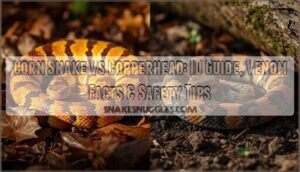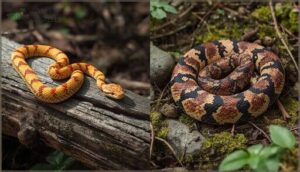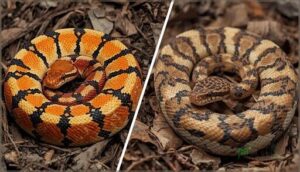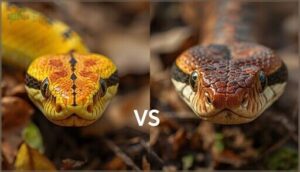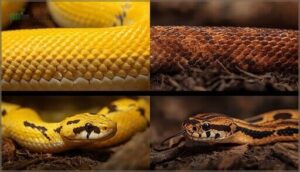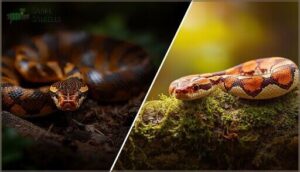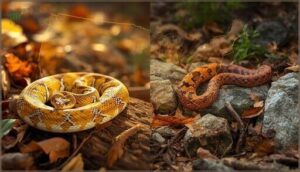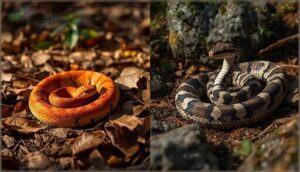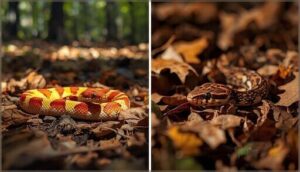This site is supported by our readers. We may earn a commission, at no cost to you, if you purchase through links.
You’re hiking a trail in Tennessee, and you spot a brown snake coiled under a log. Your heart rate jumps. Is that a harmless corn snake or a venomous copperhead? The difference could mean the difference between a photo opportunity and a trip to the emergency room.
Thousands of people face this exact dilemma each year in the southeastern United States, where both species share overlapping territory. Copperheads send more Americans to the hospital than any other venomous snake, yet they’re frequently confused with their nonvenomous look-alikes.
Learning to distinguish these two reptiles isn’t just useful trivia—it’s a practical skill that protects you, your family, and the snakes themselves from unnecessary conflict.
Table Of Contents
- Key Takeaways
- Physical Differences Between Corn Snake and Copperhead
- Venom and Safety Considerations
- Habitat and Geographic Range
- Behavior and Reproduction
- Identifying and Preventing Encounters
- Frequently Asked Questions (FAQs)
- How to tell if it’s a copperhead or corn snake?
- What snake is mistaken for a corn snake?
- What snake is mistaken for a copperhead?
- How do you tell if a snake is a corn snake?
- How can one distinguish copperheads from other non-venomous snakes?
- Are there any look-alikes to copperheads one should be aware of?
- What are the key differences between corn snakes and copperheads?
- What safety precautions are recommended when encountering copperheads?
- Are corn snakes good pets for beginners?
- How do corn snakes and copperheads differ in diet?
- Conclusion
Key Takeaways
- Copperheads display distinctive hourglass-shaped crossbands and triangular heads with vertical pupils, while corn snakes show oval blotches with black borders and round pupils—differences that matter when copperheads cause more venomous bites than any other North American snake.
- You can reliably separate these species by checking three features from a safe distance: pattern shape (hourglass versus boxed blotches), head structure (broad triangle versus narrow with spear marking), and scale texture (rough keeled versus smooth).
- Copperhead bites require immediate 911 calls and potential antivenom treatment, whereas corn snake bites need only soap and water—making accurate identification a practical safety skill rather than academic trivia.
- Both species overlap throughout the Southeast from North Carolina to Tennessee, but they prefer different microhabitats within shared territories, with copperheads favoring rocky hillsides and corn snakes choosing field edges near barns.
Physical Differences Between Corn Snake and Copperhead
When you’re face-to-face with a snake, knowing whether it’s a harmless corn snake or a venomous copperhead can make all the difference. The good news is that these two species have distinct physical features that set them apart once you know what to look for.
When you’re face-to-face with a snake, knowing whether it’s a harmless corn snake or a venomous copperhead can make all the difference
Let’s break down the key differences in size, color, head shape, and scales that’ll help you identify each snake with confidence.
Size and Body Shape
Corn snakes grow between 24 and 72 inches long, usually reaching about four to five feet at adult size. Copperheads stay shorter, usually measuring 22 to 36 inches. Despite their smaller length, copperheads have a stout, heavy body that gives them a chunky appearance, while corn snakes stay slender throughout their growth stages. At the same length, a copperhead will outweigh a corn snake.
As non-venomous snakes, corn snakes are popular pets.
Coloration and Markings
Beyond size, coloration and markings offer your clearest clues. Corn snakes display bright orange-red dorsal patterns with oval or squarish blotches outlined in black, plus a distinctive black-and-white checkerboard belly. Copperheads show tan to pinkish-tan bodies with darker brown hourglass-shaped crossbands that widen on the sides. Their ventral coloration stays cream with irregular dark blotches—never checkerboard. This is because color patterns are determined by a single gene.
Head and Eye Characteristics
When spotting a snake from a safe distance, check the head and eyes. Copperheads have broad, triangular heads with loreal pits between the nostril and eye—these are heat-sensing organs that corn snakes lack. Their vertical, slit-shaped pupils differ sharply from the round pupils in corn snakes.
Copperheads display a uniform copper crown, while corn snakes show spear-shaped head blotches and post-ocular stripes. Misidentification patterns often stem from overlooking these facial features.
Scale Patterns and Texture
Feeling scales reveals another difference. Copperheads have strongly keeled dorsal scales that feel rough, while corn snakes sport smooth or weakly keeled scales with a satin texture.
Count midbody scale rows—corn snakes usually show 27 to 29, copperheads fewer. Check the tail underside: corn snakes have divided subcaudal scales, copperheads single rows.
These ventral scale patterns offer reliable identification clues when you’re examining shed skin or handling safely.
Venom and Safety Considerations
The most important difference between these two snakes comes down to venom. Copperheads are venomous pit vipers, while corn snakes are completely harmless constrictors.
Understanding the real risks—and knowing how to respond if you encounter either species—can keep you safe and confident in the outdoors.
Venomous Vs. Nonvenomous Nature
Understanding the venom composition of these snakes matters when you’re weighing real danger. Copperheads are venomous pit vipers with hemotoxic venom that damages tissue and causes swelling at the bite site. Corn snakes lack venom glands entirely—they’re nonvenomous constrictors.
While copperhead envenomation effects require antivenom treatment in some cases, corn snake bites pose no toxic threat whatsoever.
Bite Behavior and Risks
How often do these snakes actually bite, and what happens when they do? Copperheads deliver around 2,920 bites annually in the U.S., with North Carolina reporting the highest rates. Corn snakes bite rarely—most pet owners never experience one.
Bite triggers and injury characteristics differ sharply:
- Copperhead bites happen when you accidentally step on them or handle them during outdoor activities
- Corn snake bites occur mainly during feeding, when your hand smells like prey
- Venomous snake bites cause moderate swelling in 46% of copperhead cases, while corn snake injuries remain superficial punctures
Bite severity and risk contexts favor corn snakes for safety.
First Aid and Medical Response
When you’re bitten by a suspected copperhead, immediately call 911—don’t drive yourself. Keep the bitten limb still and remove jewelry before swelling starts. Hospital staff will monitor progression and may administer antivenom (46% of cases receive 4+ vials).
Corn snake bites need only soap, water, and antiseptic. Check your tetanus status for any bite.
| Snake Type | Immediate Action | Medical Treatment |
|---|---|---|
| Copperhead | Call 911; immobilize limb at heart level | Monitor 18–24 hours; antivenom in 36–75% of cases |
| Copperhead | Remove rings and tight clothing | Lab tests track coagulopathy risk |
| Copperhead | Keep victim calm; no ice or tourniquets | Emergency escalation if swelling spreads rapidly |
| Corn Snake | Rinse with soap and water | Apply topical antibiotic; cover with sterile dressing |
| Corn Snake | Apply gentle pressure to stop bleeding | Seek care if redness, swelling, or discharge worsens |
Habitat and Geographic Range
Knowing where these snakes live can help you predict which species you’re likely to encounter in your area. Copperheads have a much broader range across the eastern and midwestern United States, while corn snakes stick to a more limited southeastern territory.
Let’s break down their distribution, preferred habitats, and where their ranges overlap.
Distribution Across The United States
You’ll find corn snakes and copperheads across different swaths of North America, though their range overlap creates confusion in many states. Here’s where each snake calls home:
- Corn snakes stretch from southern New Jersey through Florida and west to Louisiana
- Copperheads span 28 states from Massachusetts to Texas and into northern Mexico
- Regional hotspots include the Carolinas, Georgia, and Tennessee where both species thrive
- Introduced populations of corn snakes now occupy Caribbean islands beyond their natural distribution
Preferred Environments
These two snakes don’t share a preference list regarding snake habitats. Corn snakes thrive as skilled climbers in old fields, forest edges, and abandoned barns—anywhere rodents gather. Copperheads prefer rocky hillsides with leaf litter in deciduous forests. Climate influence shapes their microhabitat needs: corn snakes need 80–90°F for activity, while copperheads shift from diurnal to nocturnal behavior during hot summers.
| Feature | Corn Snake | Copperhead |
|---|---|---|
| Primary Habitat | Fields, forest edges, barns | Rocky hillsides, forests |
| Shelter Preference | Logs, debris piles, trees | Leaf litter, rock crevices |
| Temperature Range | 80–90°F preferred | 73–88°F preferred |
Overlapping Regions and Distinct Territories
Where you live determines whether you’ll encounter one snake, both, or neither. Regional co-occurrence happens throughout the Southeast—Georgia, the Carolinas, Alabama, and Tennessee all host both species in overlapping territories. Range differences become obvious farther north and west: copperheads dominate from Massachusetts to Kansas, while corn snakes stay mostly east of the Mississippi.
- Species sympatry peaks in southeastern states where both snakes share counties but use different microhabitats
- Territory dominance shifts north—copperheads occupy New England and Midwest states where corn snakes never naturally occur
- Florida’s peninsula belongs to corn snakes; copperheads stick to the panhandle and adjacent counties
- Habitat partitioning reduces competition—copperheads prefer rocky hillsides while corn snakes favor farmland edges
- Caribbean islands host only corn snakes as introduced populations, creating distinct territories without any copperhead presence
Behavior and Reproduction
Understanding how these snakes behave and reproduce helps you identify them in the wild and anticipate what they’re doing throughout the year. Corn snakes and copperheads follow completely different patterns with respect to activity, temperament, and bringing new snakes into the world.
Let’s break down the key differences that matter for identification and safety.
Activity Patterns and Temperament
Both species show seasonal activity shifts tied to temperature. Copperheads hunt primarily at night during warm months, relying on crypsis and fleeing when threatened—striking only when you step too close or corner them.
Corn snakes shift from daytime foraging in spring to nocturnal rhythms in summer heat. Their docile temperament makes handling differences clear: corn snakes tolerate human contact well, while copperheads demand cautious distance in encounter contexts.
Reproductive Strategies
Understanding reproduction reveals how you’ll encounter each species at different life stages. Corn snakes lay eggs (10–30 per clutch) in humid hideaways during late spring, with breeding seasonality peaking March through May. Copperheads are viviparous, birthing 4–7 live young in summer after bimodal mating rituals in spring and fall. Neither provides parental care, though copperheads show rare parthenogenesis—females reproducing without males.
Key reproductive differences include:
- Clutch size: Corn snakes average 10–20 eggs; copperheads deliver 6–9 live neonates.
- Breeding seasonality: Corn snakes mate in spring; copperheads mate in spring and late summer.
- Mating rituals: Copperhead males perform combat displays; corn snake courtship stays cryptic.
- Parental care: Both abandon offspring immediately after eggs hatch or birth occurs.
Juvenile Identification and Development
Once hatchlings emerge, you’ll notice corn snakes start at 8–12 inches with dark blotches that brighten to orange over successive sheds, while juvenile copperheads measure 7–9 inches with hourglass bands and a bright yellow tail tip that fades by age three.
Check head markings—corn snakes show a neck spear, copperheads a solid copper dome—and ventral patterns: corn snakes display black-and-white checkerboards, copperheads plain mottling, reducing misidentification risks.
Identifying and Preventing Encounters
Knowing what to look for can make all the difference when you spot a snake in the wild. You’ll want to recognize the right patterns and colors from a safe distance, understand which harmless species might confuse you, and know how to move through snake country without putting yourself at risk.
Let’s walk through the practical steps that’ll keep you informed and safe.
Key Identification Tips
When you’re comparing corn snakes and copperheads, focus on pattern recognition first—those distinctive hourglass crossbands versus oval blotches tell the story. Head shape and scale texture provide secondary clues, while ventral patterns confirm your suspicions if you can safely observe them.
For venomous snake identification and nonvenomous snake identification alike, expert confirmation beats guesswork every time.
Look-Alike Snake Species
Why do so many harmless snakes get mistaken for copperheads? Common misidentifications include Eastern ratsnakes, Northern watersnakes, and Eastern milksnakes—all featuring brown blotches that mimic venomous patterns. Juvenile mimicry complicates matters further: young black racers and ratsnakes display bold bands before fading to adult coloration. Regional patterns show these harmless look-alikes generate most copperhead reports.
When comparing corn snakes and copperheads alongside diagnostic traits like heat-sensing pits, you’ll avoid dangerous confusion during venomous snake identification.
Safety Precautions in Snake Habitats
In snake habitats, protective clothing like boots and long pants reduces your bite risk during peak activity from April through September. Behavioral practices matter: avoid tall grass and debris piles where copperheads hide, and never step over logs without checking the far side.
Habitat modification—removing leaf piles and dense groundcover near your home—eliminates shelter sites. Medical preparedness and community interventions complete thorough snake prevention strategies.
When to Seek Expert Help
When should you call for medical attention after a bite? If you can’t identify the snake with certainty, treat it as venomous and dial 911 immediately. Watch for bite symptoms like rapid swelling, intense pain, or breathing difficulty—signs that complications arise.
Even mild cases need expert snake advice, since worsening condition can develop hours later. Contact Poison Control (1-800-222-1222) for real-time snake bite treatment guidance and follow-up needed after hospital discharge.
Frequently Asked Questions (FAQs)
How to tell if it’s a copperhead or corn snake?
They look surprisingly alike, yet one could send you to the ER.
Check the pattern first—copperheads wear hourglass “Hershey’s kiss” bands, while corn snakes show boxy blotches with dark borders on brighter orange-red scales.
What snake is mistaken for a corn snake?
Milk snakes, juvenile rat snakes, and several banded colubrids are frequently mistaken for corn snakes due to overlapping red or brown blotches and similar body size.
This highlights why careful pattern mimicry recognition matters for accurate harmless snake identification.
What snake is mistaken for a copperhead?
Harmless mimicry trips up even experienced observers. Juvenile Eastern ratsnakes top regional misidentification lists, alongside corn snakes, water snakes, and hognose snakes—all sharing pattern confusion with copperheads despite being completely nonvenomous.
How do you tell if a snake is a corn snake?
You can identify a corn snake by checking its round pupils, smooth scale texture, and checkered belly pattern.
Look for orange or reddish body blotches bordered in black, plus distinctive head markings that form a spear-point shape.
How can one distinguish copperheads from other non-venomous snakes?
You can distinguish copperheads from nonvenomous snakes by examining their distinctive hourglass-shaped pattern recognition markings, triangular head morphology, vertical pupils, keeled scale texture, and belly patterns.
Juvenile markings include bright yellow tail tips used for luring prey.
Are there any look-alikes to copperheads one should be aware of?
Several nonvenomous mimics share copperhead patterns—milksnakes, corn snakes, and watersnakes top the list. Juvenile confusion happens when young cottonmouths resemble copperheads.
Pattern cues, habitat context, and expert ID accuracy prevent misidentification when differentiating snake species.
What are the key differences between corn snakes and copperheads?
You can separate corn snakes from copperheads by checking pupil shape, body pattern, head width, and scale texture. Corn snakes show round pupils and smooth scales, while copperheads display vertical pupils and keeled scales.
What safety precautions are recommended when encountering copperheads?
When you spot a copperhead, back away immediately and maintain a safe distance.
Wear protective clothing like boots and long pants in snake habitats. Never attempt handling—most bites happen when people disturb snakes.
Are corn snakes good pets for beginners?
Yes, corn snakes make excellent beginner pets. They’re nonvenomous, have docile temperaments, and accept frozen-thawed prey easily.
However, you’ll need secure snake enclosures and must commit to 20+ years of reptile care. Proper handling frequency and basic snake care knowledge are essential.
How do corn snakes and copperheads differ in diet?
Both species primarily hunt rodents as adults, but corn snakes actively forage and constrict prey, while copperheads ambush with venom.
Juveniles show distinct diet shifts—young corn snakes take more lizards and frogs.
Conclusion
The best snake encounter is one you never have—yet knowing the difference between a corn snake vs copperhead snake turns fear into confidence. You’ve learned to read the Hershey’s Kiss bands, check the pupils, and respect the triangular head.
That knowledge doesn’t just keep you safer in the woods; it prevents needless harm to harmless species. Next time you spot brown scales on the trail, you won’t freeze. You’ll know exactly what you’re looking at.

